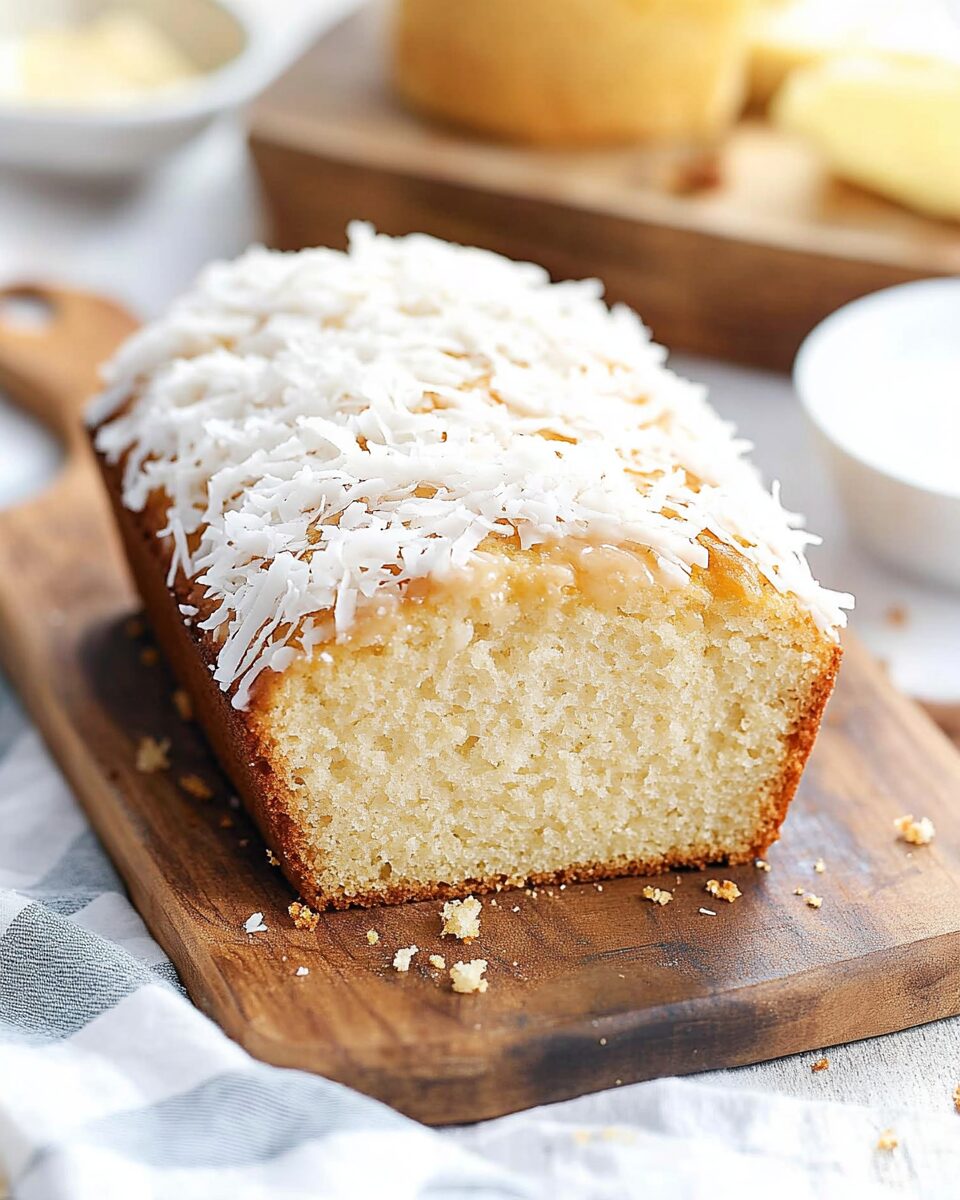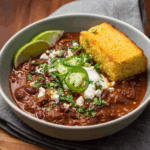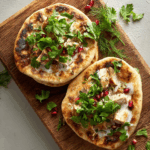There’s nothing better than a warm slice of coconut bread straight from the oven. This bread is soft and fluffy, with a tropical coconut flavor that will transport you straight to an island paradise. It’s incredibly easy to make and comes together with just a few simple ingredients, making it the perfect choice for anyone looking to bake something sweet and comforting. The coconut milk and shredded coconut give it a subtle richness that’s perfect for breakfast, a snack, or even dessert.
Whether you’re a coconut fan or just looking for something new to try, this coconut bread is a must-try recipe that will have you hooked after the first bite. It’s a fantastic option for when you want something homemade, simple, and full of flavor. If you’re craving something with a bit of tropical flair, this bread will not disappoint.
Full recipe:
Ingredients:
-
1 1/2 cups all-purpose flour
-
1/2 cup shredded unsweetened coconut
-
1/4 cup sugar
-
1 tablespoon baking powder
-
1/2 teaspoon salt
-
2 large eggs
-
1 cup coconut milk (or regular milk)
-
1/4 cup melted butter
-
1 teaspoon vanilla extract
Directions:
-
Preheat the oven to 350°F (175°C) and grease a loaf pan with butter or cooking spray.
-
In a large mixing bowl, whisk together the flour, shredded coconut, sugar, baking powder, and salt.
-
In another bowl, beat the eggs and then add the coconut milk, melted butter, and vanilla extract. Mix until smooth.
-
Slowly pour the wet ingredients into the dry ingredients and stir until just combined. Be careful not to overmix.
-
Pour the batter into the prepared loaf pan and spread it evenly.
-
Bake for 45–50 minutes, or until a toothpick inserted into the center comes out clean.
-
Allow the bread to cool for 10 minutes in the pan, then transfer to a wire rack to cool completely.
Prep Time: 10 minutes | Cooking Time: 50 minutes | Total Time: 1 hour
Kcal: 220 kcal | Servings: 8 slices
The Origins of Coconut Bread
Coconut bread is beloved across the world, especially in tropical regions where coconut is a staple ingredient. The coconut tree, which has been cultivated for centuries, thrives in areas like Southeast Asia, the Caribbean, and parts of Central and South America. In these regions, coconuts aren’t just used for their refreshing water or creamy milk—they’re also prized for their versatile meat. The shredded coconut meat is a key ingredient in many local dishes, including coconut bread.
Although coconut bread has roots in several tropical cultures, its recipes can vary from place to place. In the Caribbean, particularly in Jamaica, coconut is an integral part of many culinary delights. Southeast Asia also embraces coconut in desserts, often using coconut milk to achieve rich, velvety textures. Each region’s version of coconut bread carries unique flavors and twists, making the bread diverse and beloved worldwide.
Why You Should Try Coconut Bread
Coconut bread is far more than just another baked good. It can transform your kitchen into an exotic escape with its warm, inviting scent. The subtle yet rich coconut flavor, combined with a slightly chewy texture from the shredded coconut, creates an unforgettable eating experience.
One of the best things about coconut bread is its versatility. It pairs wonderfully with a wide variety of spreads. You can enjoy it with a simple pat of butter, indulge with cream cheese, or spread on some Nutella or fruit preserves. For an extra touch, try toasting the bread to add a delightful crunch while keeping its soft, moist interior intact.
Unlike most sweet breads, coconut bread strikes the perfect balance between sweet and savory, sitting comfortably between a cake and a loaf of bread. The moistness from the coconut milk and the slight chewiness of the shredded coconut create a satisfying and comforting experience, making it ideal for breakfast, afternoon tea, or a dessert.
Health Benefits of Coconut Bread
Coconut bread is not only delicious, but it also offers some health benefits—particularly when using natural, wholesome ingredients like coconut milk and shredded coconut. Coconut is rich in medium-chain triglycerides (MCTs), a type of fat that the body can quickly convert into energy. MCTs are often associated with improved brain function, enhanced energy levels, and even weight management by boosting metabolism.
Coconut milk, often used in the bread recipe, is packed with vitamins and minerals like potassium, magnesium, and iron, all of which are essential for maintaining good health. Unlike regular cow’s milk, coconut milk is dairy-free, making coconut bread a great option for people who are lactose intolerant or following a vegan diet. By incorporating coconut milk into the recipe, this bread becomes richer and more flavorful without relying on heavy creams or butter.
However, like any sweet treat, coconut bread should still be enjoyed in moderation. If you’re looking to make it a bit healthier, you can reduce the sugar content or even substitute whole-wheat flour to add fiber. Overall, coconut bread is a better alternative to mass-produced store-bought breads, which are often loaded with preservatives and added sugars.
Making Coconut Bread: Tips for Perfection
To bake the perfect coconut bread, there are a few essential tips to ensure you achieve the right texture and flavor:
-
Use Fresh, High-Quality Ingredients: The key to a delicious coconut bread lies in the quality of your ingredients. Use fresh, unsweetened shredded coconut and full-fat coconut milk for a creamy, rich texture. Avoid low-fat or sweetened coconut milk, as they can negatively affect both the taste and texture of the bread.
-
Avoid Overmixing the Batter: One common mistake when making coconut bread is overmixing the batter. Overmixing can result in a dense loaf. Instead, mix the ingredients gently until they’re just combined. It’s perfectly fine if the batter is a bit lumpy—this will help the bread stay light and airy.
-
Add Coconut Shreds for Extra Texture: For those who want more coconut flavor and texture, sprinkle some shredded coconut on top of the batter before baking. This creates a delightful, slightly crispy topping. If you prefer a more subtle coconut flavor, mix the shredded coconut evenly throughout the batter to infuse the bread with a consistent flavor.
-
Adjust Baking Time for Your Oven: Keep an eye on your bread as it bakes. Every oven behaves differently, and you may need to adjust the baking time. If the top of the bread begins to brown too quickly, cover it loosely with aluminum foil to prevent burning while the inside continues to bake. Test for doneness by inserting a toothpick into the center—if it comes out clean, the bread is ready.
-
Allow the Bread to Cool Completely: As tempting as it may be to dive into your fresh coconut bread, it’s essential to let it cool completely. Cooling helps the bread set, ensuring that each slice stays intact and holds its shape.
Variations and Ways to Customize Coconut Bread
Coconut bread is wonderfully versatile and can be easily customized to suit your taste preferences. Here are a few ideas to switch things up:
-
Add Citrus Zest: Infuse your coconut bread with a refreshing twist by adding zest from citrus fruits like lemons, limes, or oranges. This adds a bright, zesty flavor that complements the tropical coconut perfectly.
-
Incorporate Chocolate Chips: For a decadent treat, mix in some dark chocolate chips or extra coconut flakes for a delightful chocolate-coconut combination.
-
Make It Vegan: For a dairy-free and egg-free version, simply substitute the eggs with flax or chia eggs. Coconut oil can also be used in place of butter, enhancing the coconut flavor while maintaining the bread’s richness.
-
Spices and Cinnamon: Add a warm, comforting flavor by including a dash of cinnamon, nutmeg, or cardamom. These spices pair wonderfully with the natural sweetness of coconut, giving the bread an extra layer of warmth.
-
Nuts and Dried Fruit: For added texture and flavor, try incorporating chopped nuts such as almonds, walnuts, or macadamia nuts. Dried fruits like raisins or cranberries will add a burst of color and chewiness.
Conclusion: Why Coconut Bread is Worth Making
Coconut bread is not only a delicious treat but also an easy-to-make, versatile addition to any meal. With its soft, fluffy texture and subtle sweetness, it can be enjoyed at any time of day—from a comforting breakfast to a delightful dessert.
This bread offers more than just a tasty bite—it also has nutritional benefits, thanks to the natural goodness of coconut milk and shredded coconut. Plus, its versatility means you can tailor it to your preferences, experimenting with flavors, spices, or even chocolate chips.
Whether you’re baking for yourself, sharing it with loved ones, or bringing it to a gathering, coconut bread is bound to impress. Try baking it today, and you might just find that coconut bread becomes a new go-to recipe in your kitchen!






